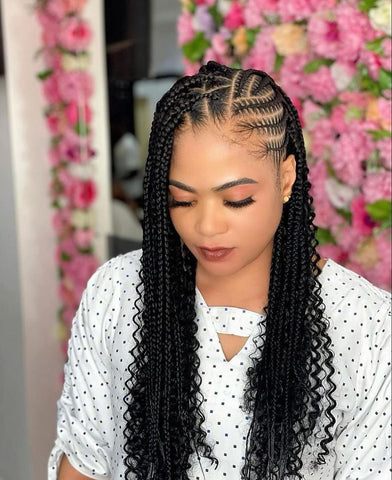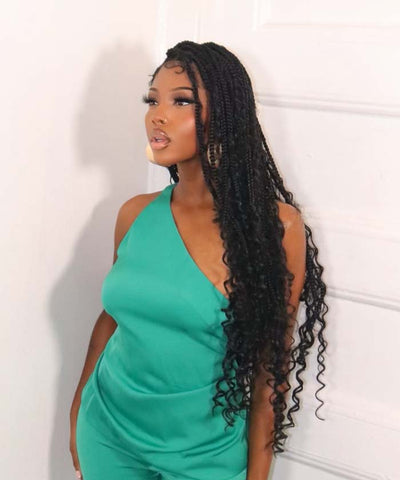Box braid wigs have become a go-to protective style for many women, offering a convenient and stylish way to switch up their look without the time-consuming installation process. However, as with any wig or protective style, it's essential to consider the potential impact on your natural hair, particularly your delicate hairline. How do you ensure a box braided wig doesn't cause tension on the hairline? This article will explore the risks of hairline damage from box braid wigs and provide you with practical tips and techniques for preserving your edges and maintaining a healthy, thriving hairline.

Understanding the Risks of Hairline Damage from Box Braid Wigs
While box braid wigs can be a fun and low-maintenance styling option, they can also pose a risk to your hairline if not worn and cared for properly. Here are some of the key factors that can contribute to hairline damage:
-
Tension: Box braids wig, especially those with heavy or tightly braided styles, can put excessive tension on your hairline, leading to traction alopecia and other forms of hair loss.
-
Friction: The constant rubbing of the wig's braids against your hairline can cause friction, leading to breakage, thinning, and even scarring.
-
Improper Fit: A wig that is too tight or too loose can cause unnecessary stress on your hairline, leading to damage over time.
-
Inadequate Moisture: Wearing a box braid wig for extended periods without properly moisturizing your natural hair can lead to dryness, brittleness, and increased susceptibility to damage.
You may like: Top 52 box braids hairstyles for Black Women in 2024: Effortless Elegance & Trendsetting Looks
Tips for Preventing Hairline Damage from Box Braid Wigs
Now that you understand the risks, let's explore some practical tips for preventing hairline damage and keeping your edges intact while rocking your favorite box braid wig styles:
Tip 1: Choose a Proper Fit and Secure Appropriately
One of the most important factors in preventing hairline damage is ensuring that your box braid wig fits properly and is secured in a way that minimizes tension. Look for wigs with adjustable straps or combs that allow you to customize the fit to your head size and shape. When securing your wig, use a wig grip or wig band to distribute the weight evenly and avoid placing excessive pressure on your hairline.
Tip 2: Opt for Lightweight, Breathable Styles
When selecting a box braid wig, consider the weight and density of the braids. Heavier styles with thicker braids can put more strain on your hairline, so opt for lightweight, breathable options whenever possible. Knotless braided wig are an excellent choice, as they tend to be lighter and more flexible than traditional box braids, reducing the risk of tension and friction.
Tip 3: Protect Your Hairline with a Barrier
To minimize friction and rubbing against your hairline, consider using a barrier between your skin and the wig. A thin, stretchy wig cap made of silk or satin can provide a smooth, slippery surface that reduces friction and helps prevent irritation. You can also use a bit of satin or silk scarf around your hairline for added protection.

Tip 4: Moisturize and Care for Your Natural Hair
Just because your natural hair is hidden beneath a wig doesn't mean it should be neglected. Regular moisturizing and conditioning are essential for maintaining the health and strength of your hairline. Use a lightweight, water-based moisturizer or leave-in conditioner to keep your hair hydrated, and consider applying a nourishing oil or serum to your edges to promote growth and prevent breakage.
Tip 5: Give Your Hair a Break
While it may be tempting to wear your box braid wig 24/7, it's essential to give your hair and scalp a break from time to time. Aim to remove your wig before bed each night, and allow your natural hair to breathe and recover. If you wear your wig for extended periods, be sure to take breaks every few weeks to assess the health of your hairline and give your hair some much-needed TLC.
You may like: Thinking Tiny: Do Small Box Braids Work Better for Short Styles?
Tips for Specific Wig Styles and Hair Types
While the general tips above apply to all box braid wig styles, there are some specific considerations for different wig types and hair textures:
Curly Box Braid Wigs
Curly box braid wigs, or braids with curls, can be particularly prone to tangling and matting, which can put extra stress on your hairline. To minimize damage, be sure to detangle your wig gently with your fingers or a wide-tooth comb before wearing, and avoid sleeping in your wig whenever possible.
Fine or Thinning Hair
If you have fine or thinning hair, you may be more susceptible to hairline damage from wigs and protective styles. Look for lightweight, breathable wig options with adjustable straps or combs for a secure, comfortable fit. Be extra gentle when removing your braided wig, and consider using a silk or satin pillowcase to minimize friction while you sleep.
Natural Hair Textures
If you have a natural hair texture, such as curly, coily, or kinky hair, you may be more prone to dryness and breakage when wearing a box braid wig. Be sure to moisturize your natural hair regularly, and consider using a sulfate-free, moisturizing shampoo and conditioner when washing your hair between wig wears.

Conclusion
Protecting your hairline is crucial when wearing box braid wigs or any protective style. By choosing a proper fit, opting for lightweight styles, using a barrier, moisturizing your natural hair, and giving your hair a break, you can prevent damage and maintain a healthy, thriving hairline.
Remember to listen to your hair and scalp, and don't hesitate to take a break or seek professional advice if you notice any signs of damage or discomfort. With the right care and attention, you can rock your favorite box braid wig styles with confidence, knowing that your edges are safe and sound.

























































































Share:
Extend the Life of Your Synthetic Braids: Pro Tips for Wig Longevity
Maintaining Magic: Determining Optimal Retouch Frequency for Tangle Control